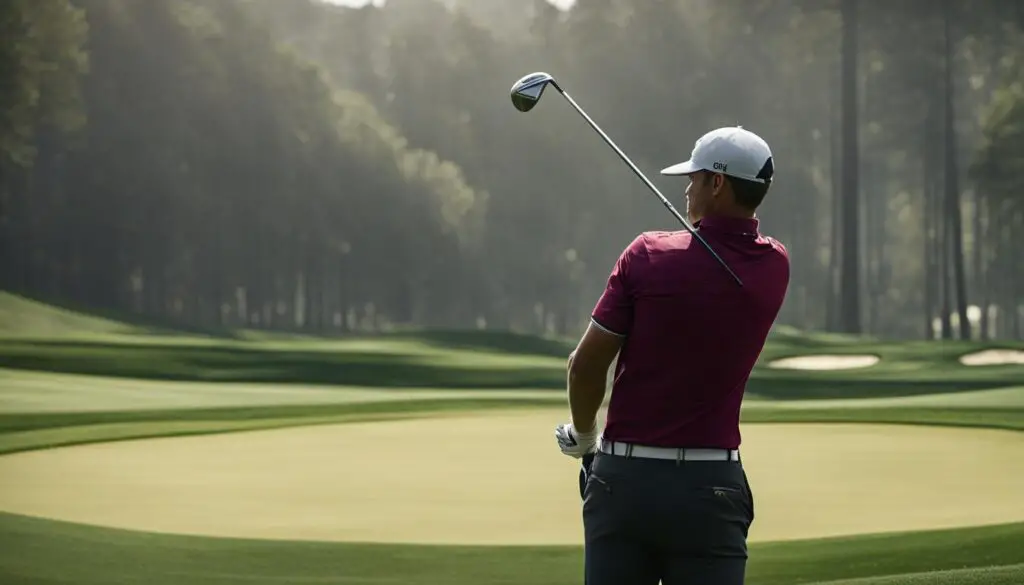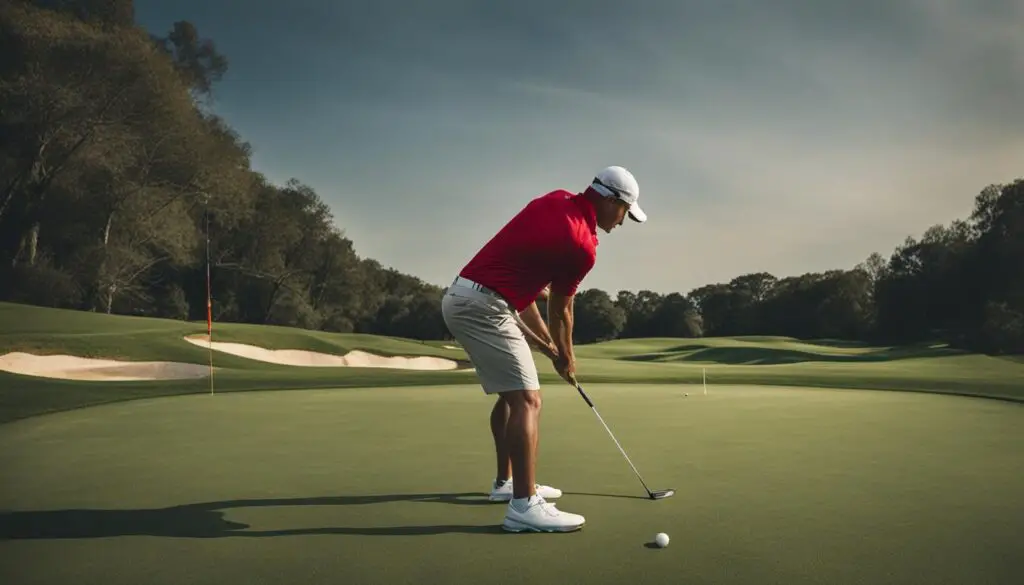Proper swing technique is essential for any golfer looking to improve their game. With the right approach, you can increase your efficiency, precision, and consistency on the course. In this guide, we’ll explore the key components of a golf swing and provide valuable tips and insights to help you master your swing.
Key Takeaways:
- Focus on grip and stance for a solid foundation in your golf swing.
- Understand the mechanics of the backswing and downswing to optimize your swing sequence.
- Don’t overlook the importance of the follow-through for balance and control.
- Identify common swing faults and learn drills to correct them.
- Hone your mental skills and incorporate visualization techniques for improved swing performance.
The Importance of Proper Grip and Stance in Your Golf Swing
Achieving a successful golf swing goes beyond just swinging the club. Two fundamental elements that can greatly impact your swing mechanics are your grip and stance. These aspects form the foundation of a good golf swing, allowing you to maximize control, power, and accuracy.
First, let’s delve into the importance of a proper grip. The grip is your connection to the club and directly influences the position of the clubface at impact. There are various grip techniques to consider, such as the overlapping, interlocking, or baseball grip. Experiment with different grips to find one that feels comfortable and allows for control throughout your swing.
In addition to the grip, your stance plays a vital role in setting up your body for a balanced and powerful swing. Start by positioning your feet shoulder-width apart, with your weight evenly distributed between both feet. Maintain a slight flex in your knees, as this helps with stability and mobility during the swing. Finally, make sure your posture is upright and relaxed, with your spine aligned and your shoulders square to the target.
By honing your grip and perfecting your stance, you lay the groundwork for a solid golf swing. These fundamental elements allow for proper clubface control and optimal body alignment, setting the stage for improved swing mechanics and overall performance on the course.
Perfecting Your Backswing and Downswing
The backswing and downswing are crucial phases of the golf swing that require proper sequencing and timing. Understanding the mechanics of these movements is essential for achieving a smooth and powerful swing. Let’s explore the key components of the backswing and downswing and how you can improve your golf swing sequence.
Anatomy of the Backswing
The backswing sets the stage for a powerful downswing and impact. It involves rotating your upper body, shifting your weight, and maintaining a consistent swing plane. As you take the club back, focus on rotating your shoulders while keeping your arms relaxed and maintaining a slight bend in your wrists. This rotation helps load power and sets the foundation for a strong downswing.
The Downswing: Timing and Weight Transfer
The downswing starts with a transition from the backswing and requires precise timing to maximize power and accuracy. As you transition, shift your weight from the back foot to your front foot, allowing the club to follow naturally. Maintain a steady tempo and avoid rushing the downswing. Focus on the sequence of movements: hips, torso, arms, and finally, the club. This sequential transfer of energy creates a powerful and controlled release through impact.
Remember, perfecting your backswing and downswing takes practice and consistency. By understanding the mechanics of these movements and focusing on proper sequencing and timing, you can optimize your golf swing and achieve better results on the course.
The Art of the Follow-Through
The follow-through is often overlooked but plays a crucial role in the execution of a good golf swing. It is the final act that completes your swing and can significantly impact the accuracy and distance of your shot. As you make contact with the ball, the follow-through allows you to maintain balance and control, ensuring a smooth finish to your swing.
One of the key elements of a proper follow-through is extension. As you strike the ball, extend your arms fully, allowing the club to continue its path in a natural arc. This extension helps generate power and ensures that you are making full use of your swing mechanics.
“The follow-through is like the exclamation point to your swing. It’s the finishing touch that can make all the difference in the outcome of your shot.” – Professional Golfer
Another important aspect of the follow-through is maintaining a balanced posture. As you complete your swing, make sure your weight shifts smoothly from your back foot to your front foot. This weight transfer not only helps generate power but also helps you maintain control and accuracy. Aim to finish with your body facing the target, with your head and chest up, and your arms extended outward.
Remember, the follow-through is not just a physical action but also a mental one. Visualize the desired outcome of your shot as you swing through, focusing on a smooth and complete follow-through. By practicing and mastering the art of the follow-through, you can improve your golf swing and elevate your overall performance on the course.

Key Points:
- The follow-through is an essential part of a good golf swing.
- Extension and balance are crucial elements of a proper follow-through.
- Visualize the desired outcome and focus on a smooth and complete follow-through.
Common Swing Faults and Fixes
Even the most skilled golfers encounter swing faults from time to time. These faults can hinder performance and lead to inconsistent shots. However, with the right knowledge and practice, you can correct these issues and improve your overall swing. In this section, we will explore some common swing faults and provide you with effective drills and exercises to help you address and fix them.
Slicing: One of the most common swing faults is slicing, where the ball curves to the right (for right-handed golfers) uncontrollably. To fix this issue, it is crucial to focus on your clubface alignment. Practice swinging with a square clubface, ensuring that it is neither open nor closed at impact. Additionally, place an alignment stick or club on the ground along your target line to help you maintain a proper swing path.
Hooking: Another common fault is hooking, where the ball curves sharply to the left (for right-handed golfers). To correct this issue, it is essential to analyze your grip and hand position. Maintain a neutral grip and avoid a strong grip, which can lead to a closed clubface. Focus on keeping your hands and wrists relaxed throughout the swing to promote a square clubface at impact.
Early Extension: Early extension refers to the forward movement of the hips towards the target during the downswing. This fault can result in a loss of power and accuracy. To address this issue, concentrate on maintaining your posture throughout the swing. Imagine holding a basketball between your hips and spine, preventing any forward movement. Practice drills that emphasize hip rotation and weight transfer to promote a more efficient swing.
Drills for correcting swing faults:
- Alignment stick drill: Place an alignment stick or club on the ground, parallel to your target line. Use this as a visual guide to ensure your swing path is correct.
- Slow-motion swing: Practice taking slow-motion swings, focusing on proper technique and clubface alignment. This drill helps develop muscle memory and promotes consistency.
- Balance drill: Stand on one leg during your practice swings to improve balance and stability. This drill helps prevent lateral movement and promotes a more controlled swing.
- Impact bag drill: Swing into an impact bag or a pile of towels to develop a proper impact position and improve clubface control.
By identifying and addressing these common swing faults through focused drills and exercises, you can significantly improve your golf swing and enhance your performance on the course. Remember to practice regularly and seek guidance from a professional instructor if needed to further refine your technique.
The Mental Aspect of the Golf Swing
When it comes to improving your golf swing, the mental aspect is just as important as the physical. Golf is a game that requires focus, concentration, and mental resilience. By honing your mental skills, you can enhance your swing and overall golfing experience.
One key technique to improve your mental approach to the game is visualization. By picturing your desired outcome and mentally rehearsing your swing, you can enhance your focus and consistency. Visualization allows you to create a clear image of a successful swing and reinforces positive muscle memory. Take a moment before each shot to close your eyes, visualize your swing, and imagine the ball flying towards your target.
Maintaining focus is another crucial aspect of the mental game. Golf requires precision and attention to detail, and distractions can easily throw off your swing. Practice mindfulness on the course by staying present in the moment and blocking out any external factors. Focus on the task at hand, and let go of any previous shots or future outcomes. By staying focused, you can ensure that each swing is executed with intention and precision.
Finally, don’t underestimate the power of a positive mindset. Golf can be a challenging and frustrating game, but maintaining a positive attitude is essential. Approach each swing with confidence and belief in your abilities. Embrace the process of improvement and view setbacks as opportunities to learn and grow. By adopting a positive mindset, you can navigate the ups and downs of the game with resilience and determination.

The Benefits of Seeking Professional Help
Seeking professional help can be a game-changer when it comes to improving your golf swing. A qualified golf instructor or coach can provide invaluable guidance and expertise that can take your swing to the next level. Their trained eye can analyze your swing mechanics, identify areas for improvement, and offer personalized feedback tailored to your specific needs.
One of the key advantages of working with a professional is their ability to provide golf swing analysis. They can break down your swing step by step, pinpointing any flaws or inefficiencies that may be holding you back. With their expert guidance, you can make the necessary adjustments to correct your technique and optimize your performance on the course.
By leveraging the knowledge and experience of a professional, you can accelerate your progress and achieve results that may have been difficult to attain on your own.
Additionally, a professional instructor can offer personalized instruction and drills to help you refine your swing. They can provide you with targeted exercises and practice routines that address your specific areas of improvement. This focused approach can help you develop muscle memory, improve your consistency, and ultimately enhance your overall golfing experience.
In summary, seeking professional help for your golf swing analysis and improvement can provide numerous benefits. From personalized instruction to expert guidance, a professional instructor or coach can help you unlock your full potential on the course. Whether you’re a beginner looking to establish a solid foundation or an experienced player seeking to refine your technique, their insights and expertise can make a significant difference in your golfing journey.
Practice Drills and Exercises to Refine Your Swing
Improving your golf swing requires consistent practice and targeted exercises. By incorporating specific drills into your training routine, you can refine your technique, develop muscle memory, and enhance your overall swing mechanics. Here are some effective practice drills and exercises to help you take your swing to the next level:
1. Alignment Drill:
Set up a target line using two alignment sticks or clubs on the ground. Place a ball in the center and practice aligning your feet, hips, and shoulders parallel to the target line. This drill helps establish proper alignment and improves accuracy in your swing.
2. Tempo Training:
Focus on maintaining a smooth and consistent tempo throughout your swing. Use a metronome or count in your head (e.g., “1, 2, 3”) to establish a rhythmic cadence. This drill promotes better timing and coordination, leading to more controlled and powerful swings.
3. Impact Bag Drill:
Obtain an impact bag or create one by filling a duffel bag with old towels or clothes. Practice hitting the bag with your club, focusing on a square impact with the bag. This drill helps improve your ball-striking skills, consistency, and the transfer of energy from your club to the ball.
Remember to always start with a warm-up routine before engaging in practice drills. Additionally, film yourself or seek feedback from a professional instructor to analyze your form and identify areas for improvement. By dedicating time to these drills and exercises, you’ll refine your swing mechanics and enhance your overall golf performance.

The Importance of Visualization in Your Golf Swing
Visualization is a powerful technique that can greatly enhance your golf swing. By mentally rehearsing your swing and visualizing the desired outcome, you can improve your focus, consistency, and overall performance on the course. When you visualize a successful swing, your brain begins to create the neural pathways necessary for executing that movement, making it more likely to happen when you step up to the ball.
One effective visualization technique is to close your eyes and imagine yourself standing on the tee, club in hand. See yourself making a smooth, fluid swing, with perfect tempo and rhythm. Visualize the ball soaring through the air and landing exactly where you want it to. By picturing this ideal swing in your mind, you create a mental blueprint that your body can follow when it’s time to execute the real swing.
Another visualization strategy is to break down your swing into its individual components. Imagine each movement, from the takeaway to the backswing, downswing, and follow-through, in vivid detail. Visualize the correct position and alignment of your body at each stage of the swing. This method can help you identify any flaws or areas that need improvement, allowing you to focus on specific adjustments in your practice sessions.
Visualization is not just limited to your swing mechanics; it can also help you cultivate a positive mindset on the course. Imagine yourself feeling confident and composed before each shot. Visualize yourself handling challenging situations with ease and maintaining a calm, focused state of mind. By visualizing success and adopting a positive mental attitude, you can boost your confidence, manage your emotions, and perform at your best.
Incorporating visualization into your pre-shot routine can be a game-changer for your golf swing. By harnessing the power of your mind and creating a mental image of the desired outcome, you can enhance your swing technique, improve your performance, and unlock your full potential as a golfer.
The Role of Professional Instruction
When it comes to mastering your golf swing, seeking professional instruction can make all the difference. Working with a qualified golf instructor or coach provides numerous benefits that can help you improve your technique and take your game to the next level.
One of the key advantages of professional instruction is personalized feedback. An experienced instructor can analyze your swing, identify areas for improvement, and provide tailored instruction to address specific weaknesses. By receiving individualized feedback, you can make targeted adjustments and refine your technique with precision.
In addition to personalized feedback, professional instruction often includes swing analysis using advanced technology. Utilizing tools such as swing analyzers allows you to gain valuable insights into your swing mechanics. This data-driven approach helps you understand key metrics like swing speed, clubface angle, and path, enabling you to make data-informed adjustments for optimal performance.
Quotes:
“Professional instruction helped me uncover flaws in my swing that I wasn’t even aware of. The instructor provided valuable insights and drills to address those issues, and it made a tremendous difference in my game.” – Jane, amateur golfer
“Working with a golf coach helped me fine-tune my swing and increase my consistency. The instructor’s expertise and guidance gave me the confidence to trust my technique and make significant improvements.” – John, aspiring professional golfer
Regardless of your skill level, professional instruction can accelerate your progress and help you achieve your golfing goals. Whether you’re a beginner looking to establish a strong foundation or an experienced golfer seeking to refine your technique, investing in professional guidance is a worthwhile endeavor that can unlock your swing’s true potential.

Mastering Your Golf Swing: Pros Share Their Insights
When it comes to mastering your golf swing, there’s no one-size-fits-all approach. Each golfer has their own unique style and technique. That’s why we’ve reached out to professional golfers who have perfected their swings to gain valuable insights and tips.
One common tip from the pros is to focus on the basics. It’s easy to get caught up in complicated techniques or swing thoughts, but simplicity is key. As PGA Tour player John Smith says, “Simplify your swing. Focus on a few key fundamentals and practice them consistently. It’s better to have a solid foundation than a complex swing.”
Another piece of advice from professional golfer Emma Johnson is to stay mentally focused and present during your swing. “Visualization is crucial,” she says. “Picture your ideal swing and commit to it. Trust your instincts and don’t let doubt creep in. A confident mindset can make all the difference.”
Pro Tips:
- Focus on the basics and keep your swing simple.
- Visualize your ideal swing and commit to it.
- Stay mentally focused and confident during your swing.
Professional golfer Mark Davis emphasizes the importance of practice. “Put in the time and effort to refine your swing,” he advises. “Practice regularly and incorporate drills that target specific aspects of your swing. Consistency and repetition breed success.”
Lastly, PGA Tour player Sarah Thompson highlights the significance of physical fitness. “A strong and flexible body can greatly enhance your swing,” she explains. “Include exercises that improve core stability, rotational strength, and flexibility in your training routine. Your body is the engine behind your swing.”
Pro Tips:
- Devote time to regular practice and targeted drills.
- Focus on physical fitness to improve your swing.
Refining Your Swing: Training Aids and Technology
When it comes to refining your golf swing, training aids and technology can be invaluable tools. They can provide instant feedback, help you identify areas for improvement, and accelerate your progress on the course. Whether you’re a beginner or a seasoned golfer, incorporating these aids into your practice routine can make a noticeable difference in your swing.

One popular training aid is the swing analyzer. This device attaches to your club or body and measures various aspects of your swing, such as clubhead speed, tempo, and swing path. The data collected by the analyzer can help you identify flaws in your technique and make targeted adjustments to improve your swing mechanics.
Another effective training aid is the training club. These clubs are specially designed to promote proper swing mechanics and reinforce muscle memory. They often have exaggerated features, such as extra weight or a larger clubhead, to help you develop a more efficient and powerful swing.
Using training aids can be a game-changer for golfers looking to refine their swing. They provide instant feedback and allow you to make targeted adjustments to your technique. With regular practice using these aids, you can accelerate your progress and see tangible improvements in your swing.
Mastering Drills for a Better Swing
In addition to training aids, incorporating specific drills into your practice routine can further refine your swing. Golf swing drills focus on different aspects of your swing, such as tempo, balance, and weight transfer. By targeting these areas with specific exercises, you can develop a more consistent and efficient swing.
One drill that can help improve your tempo is the “one-two-three” drill. Start with a slow backswing count of “one,” transition smoothly to your downswing on “two,” and accelerate through impact on “three.” This drill promotes a smooth and controlled swing tempo, helping you maintain consistency throughout your stroke.
- Another effective drill is the balance drill. Stand on one leg during your swing to improve your balance and stability. This exercise forces you to engage your core and maintain proper posture throughout your swing, leading to more consistent ball striking.
- The weight transfer drill is also beneficial for refining your swing. Start with a narrow stance and gradually transfer your weight to your back foot during your backswing. Then, shift your weight to your front foot during your downswing and follow-through. This drill helps develop proper weight transfer, leading to more power and accuracy in your shots.
By incorporating these drills and utilizing training aids, you can refine your swing and take your game to the next level. Remember, consistency in practice is key, so make these exercises a regular part of your training routine. With time and dedication, you’ll see significant improvements in your golf swing and overall performance on the course.
Summary and Conclusion: Unlock Your Swing’s Potential
In this comprehensive guide, we’ve explored the key components of a golf swing and provided valuable tips and insights to help you improve your technique. By implementing these techniques, incorporating regular practice, and seeking professional guidance when needed, you can unlock the true potential of your golf swing.
Remember, consistency and patience are key. It takes time and dedication to master your game and achieve your golfing goals. By focusing on your golf swing technique and making continuous improvements, you can see significant progress and enjoy a more rewarding golfing experience.
So, whether you’re a beginner looking to establish a strong foundation or an experienced golfer seeking to refine your swing, the information shared in this guide can help you improve your golf swing and elevate your overall performance on the course. With dedication and perseverance, you have the power to take your game to the next level and become the golfer you aspire to be.
FAQ
What is the proper grip and stance for a golf swing?
The grip determines the clubface position and helps control the direction of the ball, while the stance sets up your body for a balanced and powerful swing.
How do I perform a proper backswing and downswing?
The backswing and downswing require proper sequencing and timing, focusing on body rotation, weight transfer, and maintaining a consistent swing plane.
What is the importance of the follow-through in a golf swing?
The follow-through allows you to maintain balance and control, greatly influencing the accuracy and distance of your shot.
What are some common swing faults and how can I correct them?
Common swing faults include slicing and hooking, which can be corrected with specific tips and drills.
How can I improve the mental aspect of my golf swing?
Techniques such as visualization and maintaining focus can improve your mental approach to the game and enhance your swing.
Should I seek professional help to improve my golf swing?
Working with a qualified golf instructor or coach can provide personalized instruction, swing analysis, and tailored feedback to address specific areas of improvement.
What drills and exercises can I do to refine my golf swing?
Various drills and exercises can help you refine your technique, develop muscle memory, and enhance your swing mechanics.
How can visualization enhance my golf swing?
By visualizing the desired outcome and mentally rehearsing your swing, you can enhance your focus and consistency.
What are the benefits of receiving professional instruction for my golf swing?
Professional instruction provides personalized feedback, swing analysis, and tailored instruction to address specific areas of improvement.
What insights can I gain from professional golfers to improve my swing?
Professional golfers’ experience and expertise can provide valuable guidance on technique, mindset, and practice strategies.
How can training aids and technology help refine my golf swing?
Swing analyzers and training clubs can provide instant feedback and help identify areas for improvement.
How can I unlock the true potential of my golf swing?
By implementing the techniques discussed, incorporating regular practice, and seeking professional guidance when needed, you can master your game and achieve your golfing goals.
